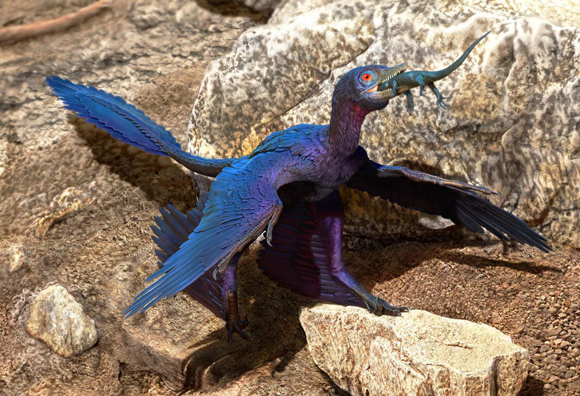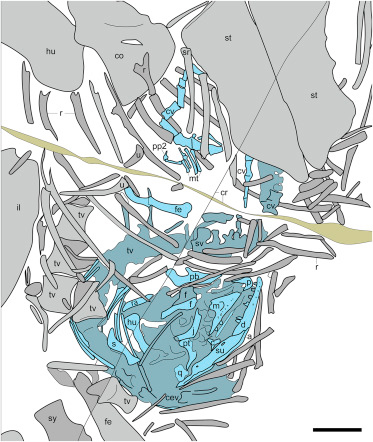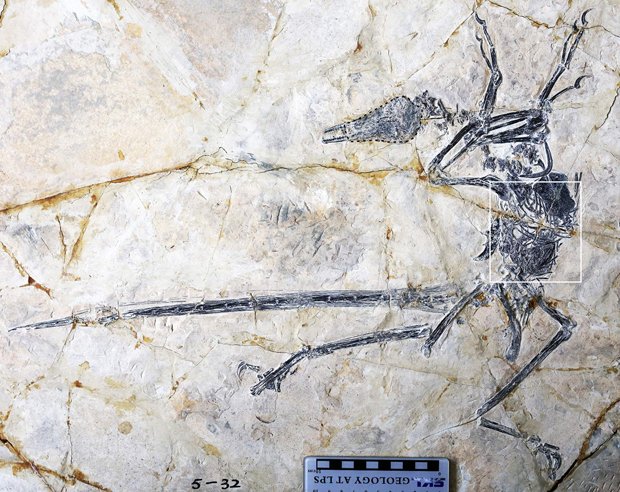New Study Suggests Microraptor Ate Lizards
Stomach Contents Reveal New Species of Early Cretaceous Lizard
Scientists writing in the academic journal “Current Biology”, have described a new specimen of Microraptor (M. zhaoianus) from Liaoning Province (north-eastern China), that preserves the remains of a small lizard in its body cavity. The remains of the lizard, inside what would have been the stomach of this little feathered dinosaur, are largely intact and articulated. This indicates that the unfortunate lizard was swallowed head first, a feeding behaviour seen in extant carnivorous birds and many small reptiles. The fossilised bones of the lizard represent a new species, it has been named Indrasaurus wangi.
Microraptor is now known to have fed on a variety of small vertebrates, supporting the interpretation that it was an opportunistic predator.
Microraptor About to Swallow the Unfortunate Indrasaurus

Picture credit: Doyle Trankina
Direct Evidence of Predator-Prey Interactions from the Jehol Biota
Direct evidence of diet and predator-prey relationships are extremely rare in the fossil record. However, the exceptional preservation conditions associated with the Liaoning deposits have resulted in four examples of stomach contents in Microraptor specimens having been identified. Microraptor is now known to have been a generalist, eating a variety of small vertebrates including mammals, birds, fish, and with this new discovery, lizards.
Photograph of the Microraptor Specimen (STM5-32) Preserving the Lizard Indrasaurus wangi in the Body Cavity
Picture credit: O’Connor et al (Current Biology)
Lizard Remains in Microraptor Stomach Cavity
The white lines in the photograph indicate the body cavity area of the Microraptor and show the location of the lizard fossil remains. The genus name Indrasaurus comes from Hindu scriptures in which the deity Indra was swallowed by the dragon Vritra during their battle. The species (trivial name), honours Yuan Wang, for his extensive work on the Jehol Biota and his assistance in helping to promote Chinese fossils through museum events and exhibitions.
An Interpretative Line Drawing Showing the Remains of Indrasaurus (I. wangi) in the Abdominal Cavity

Picture credit: O’Connor et al (Current Biology)
The interpretative drawing (above), shows the contents within the white box outlined in the specimen (STM5-32). Analysis of the lizard’s bones indicate that it was probably a sub-adult when it met its doom. Ironically, the Microraptor itself died shortly after eating the lizard, although this would probably have not been much comfort to Indrasaurus had it known this at the time.
For models and replicas of dromaeosaurids such as Microraptor: CollectA Deluxe Prehistoric Life.
How Did Microraptor Catch Lizards?
Most scientists believe that Microraptor could fly, it is not known whether this little lizard was caught in a tree or captured on the ground after a terrestrial pursuit. Perhaps Microraptor swooped down onto its prey from a lofty vantage point, a tactic common to many carnivorous birds today.
The probable troodontid Anchiornis from the older Late Jurassic Yanliao Biota is roughly the same size as Microraptor and fossils of Anchiornis reveal that this dinosaur ate lizards too. However, comparison of the fossilised remains of prey suggests that dromaeosaurids such as Microraptor ingested prey that were fully digested, whereas, Anchiornis may have regurgitated undigested body parts, bringing up a pellet as demonstrated in many bird species alive today. This feeding behaviour supports a closer relationship between true birds and Anchiornis and suggests that powered flight did not precipitate the evolution of pellet regurgitation (egestion), in these reptiles.
The scientific paper: “Microraptor with Ingested Lizard Suggests Non-specialized Digestive Function by Microraptor with Ingested Lizard Suggests Non-specialized Digestive Function” by Jingmai O’Connor, Xiaoting Zheng, Liping Dong, Yan Wang, Xiaomei Zhang and Zhonghe Zhou published in the journal “Current Biology”.
The Everything Dinosaur website: Everything Dinosaur Website.


